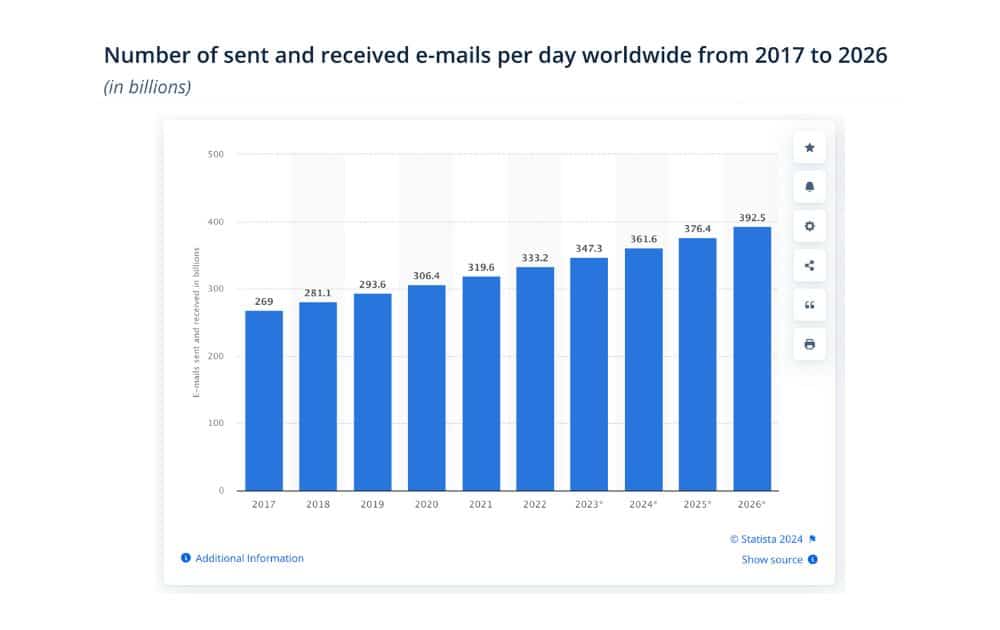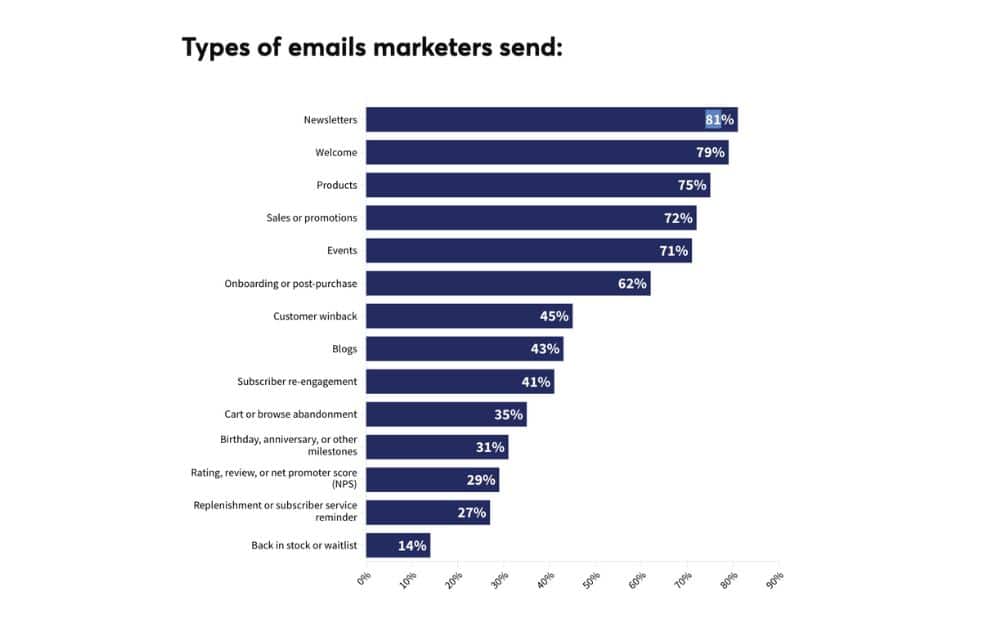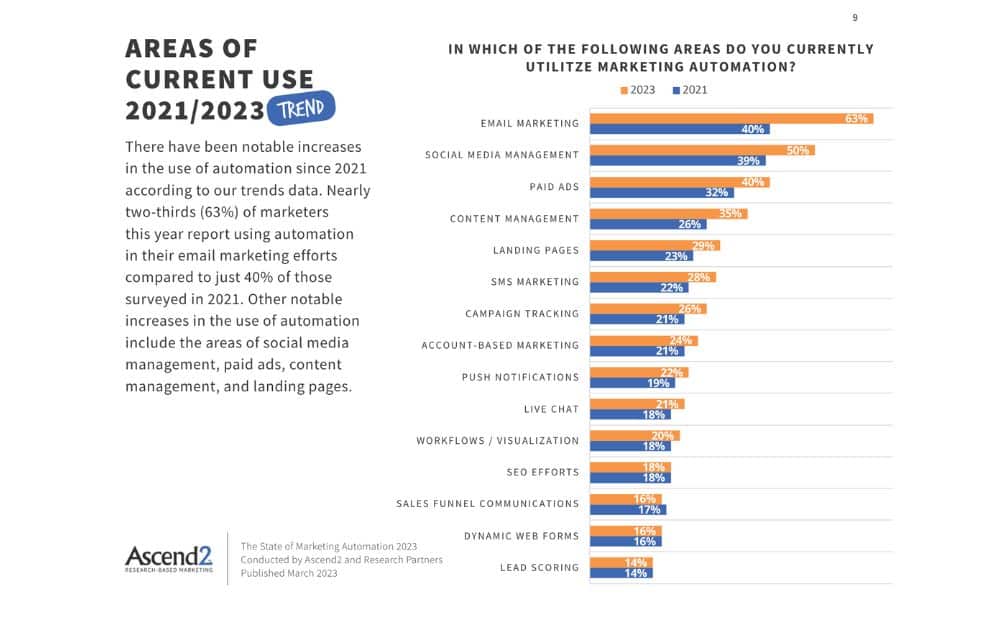
How often do you open your email? If you’re like most people, you probably peek at least once a day. This is backed by findings from Hubspot, stating that over 84.3% of consumers open their emails daily.
This widespread habit underscores the importance of tapping into email marketing to reach consumers effectively. It also explains why learning how to use email marketing automation tools is so critical.
But what does email marketing automation really entail? Why is it a must-have in your digital strategy toolkit?
What is Email Marketing Automation?
Email marketing automation is an approach that allows businesses to send messages to their audience without the need for constant manual effort.
Projections cited by Statista indicate that by 2026, the volume of emails exchanged worldwide will rise to approximately 392.5 billion emails each day.

This huge volume underscores the critical importance of email marketing automation. With billions of emails flooding inboxes daily, standing out in a crowded field becomes a formidable challenge.
Email marketing automation tools address this challenge by enabling businesses to send relevant, personalized, and timely messages.
This strategic targeting helps ensure that emails are not only delivered but also noticed and acted upon, thereby increasing the effectiveness of marketing campaigns and improving customer engagement.
What is an Email Marketing Automation Tool?
Email marketing automation tools are specialized software designed to help marketers and businesses automate their email communication.
Here are some of the types of messages you can use email marketing automation tools for:
- Welcome Emails. Automatically sent to new subscribers or customers to introduce your brand and set the tone for future communications.
- Transactional Emails. May include order confirmations, receipts, and shipping notifications triggered by a customer’s specific actions.
- Re-engagement Emails. Sent to inactive subscribers to encourage them to interact with your brand again, possibly offering incentives.
- Cart Abandonment Emails. Targeted messages sent to users who have left items in their shopping cart without completing the purchase.
- Birthday or Anniversary Emails. Personalized greetings or offers sent on special dates related to the subscriber.
- Newsletters. Regularly scheduled emails that provide updates, news, or tips relevant to your subscribers.
- Follow-up Emails. Sent after a customer has interacted with your service or product, often to gather feedback or promote further engagement.
Data from Constant Contact shows that newsletters, welcome emails, product emails, sales promotions, and event invites are the top five types of emails marketers send.

This information aligns seamlessly with the capabilities of email marketing automation tools, which are designed to optimize and streamline the sending of these popular types of emails.
Benefits of Email Marketing Automation
Data from Ascend2 highlights email marketing as the most commonly utilized area for marketing automation, with 63% or almost two in every three marketers using it for marketing efforts in 2023.

This number is a significant jump from 40% recorded in 2021 and is only expected to increase through the years. The data reflects how businesses are leveraging email marketing automation tools to reap benefits, including the following:
- Enhanced Efficiency. Scheduling campaigns in advance, using triggers to send emails at optimal times without continual oversight, thus saving time and resources.
- Consistency in Communication. Email marketing automation software allows you to maintain regular and consistent communication with your audience, ensuring your brand stays top-of-mind and strengthens customer relationships.
- Scalability. Manage large volumes of email without compromising the personal touch, allowing businesses to scale their marketing efforts as they grow.
- Improved ROI. Targeted and timely messages lead to higher conversion rates. Automation ensures that your marketing efforts are more measurable, allowing for refined strategies that directly impact the bottom line.
- Advanced Analytics. With built-in analytics tools, email marketing automation provides detailed reports on the performance of your campaigns, offering insights into open rates, click-through rates, and conversions, which help in making data-driven decisions.
- Increased Personalization. By utilizing data insights, automation tools enable the customization of messages based on user behavior, preferences, and previous interactions. An email trends report highlights how the use of AI in email marketing is significantly enhancing personalization capabilities and helping boost engagement.

Best Email Marketing Automation Tools
Here are some of the most popular email marketing automation tools used by businesses of all sizes:
| Email Marketing
Automation Tool |
Best for | Pricing | Key Features |
| Mailchimp | Comprehensive marketing solutions | Offers a free version; premium plans begin at $13 monthly. | Easy integration, comprehensive automation, intuitive design |
| MailerLite | Advanced marketing needs | Free for basic use; starts at $10 per month for advanced features | Advanced targeting, user-friendly design, robust analytics tools |
| ActiveCampaign | Complex automation needs | Starting at $15 per month, with a 14-day free trial is available | High-level automation, detailed tracking, CRM integration |
| HubSpot | Extensive marketing tools | Free limited plan; paid plans start at $15 per month per seat | Full marketing suite, CRM capabilities, extensive analytics |
| Drip | Ecommerce businesses | Plans begin at $39 per month, with a 14-day free trial is available | E-commerce optimization, multi-channel support, automation |
1. Mailchimp
Known for its user-friendly interface, Mailchimp is one of the automation tools for email marketing ideal for those just starting out or needing an all-in-one solution.
Mailchimp offers a generous free plan that supports up to 1,000 sends per month, making it perfect for small businesses looking to grow.
The platform’s paid plans start at $13 per month and offer more features, including pre-built email templates, access to creative assistant, predictive segmentation, and advanced targeting.
Mailchimp also offers pre-built journeys that allow users to cross-sell products and recover abandoned carts.
2. MailerLite
Best suited for advanced email marketers, MailerLite allows dynamic content blocks and offers a free plan for up to 1,000 subscribers and 12,000 monthly emails. This makes it a great choice for those who want sophisticated capabilities without a hefty price tag.
MailerLite’s paid plans start at $9 per month, which comes with unlimited monthly emails, access for three users, and unlimited templates.
The platform uses real-time reports to track audience engagement, metrics, and overall growth, helping increase email click-throughs and conversion rates.
3. ActiveCampaign
Recognized for its extensive automation capabilities, ActiveCampaign is best for businesses that want to automate complex email sequences.
While it doesn’t offer a free plan, its robust features justify the investment, and you can opt for a 14-day free trial before committing to a paid plan.
This platform is among the email marketing automation tools that integrate effortlessly with significant services like Shopify, WordPress, and Salesforce, enhancing its utility.
This versatility supports various industries, enabling them to automate critical marketing processes, cultivate lasting customer relationships, and drive significant revenue growth through targeted campaigns.
4. HubSpot
With its well-rounded marketing features, HubSpot serves those looking for an extensive tool that goes beyond email marketing to include CRM and other marketing functions. It offers a free plan that allows users to generate and email new leads without spending anything.
HubSpot is renowned for its comprehensive approach to marketing, extending well beyond just email marketing to incorporate CRM functionalities and a broad spectrum of marketing tools. The platform is ideal for businesses seeking a holistic marketing solution.
5. Drip
Specifically designed for ecommerce businesses, Drip integrates deeply with ecommerce platforms to automate emails based on customer behavior and purchase history.
Drip´s powerful segmentation and personalization capabilities make it a top choice for online stores looking for automation tools for email marketing.
The platform supports complex automation with ease, using a visual drag-and-drop builder to create sophisticated marketing workflows that cater to detailed consumer behaviors. This functionality empowers online stores to elevate their marketing strategies, fostering enhanced customer engagement and increased sales.
Frequently Asked Questions (FAQs)
How do you automate email marketing?
Start by reviewing email marketing automation solutions and select one that suits your needs. Then, set up automated workflows that trigger emails based on specific actions your subscribers take. For example, signing up, making a purchase, or engaging with previous emails.
These tools allow you to schedule campaigns, segment your lists for targeted messaging, and analyze the results to refine future strategies.
Which tool is best for email marketing?
The best email marketing automation software varies depending on your specific requirements and goals. For instance, if you’re using email marketing for ecommerce, it’s best to choose a platform that specializes in ecommerce email marketing automation or Amazon automation.
Each platform offers unique features. So it’s best to evaluate them based on your budget, the size of your email list, and the complexity of your email campaigns.
Author
 Carla Bauto Deña is a journalist and content writer producing stories for traditional and digital media. She believes in empowering small businesses with the help of innovative solutions, such as ecommerce, digital marketing, and data analytics.
Carla Bauto Deña is a journalist and content writer producing stories for traditional and digital media. She believes in empowering small businesses with the help of innovative solutions, such as ecommerce, digital marketing, and data analytics.
Discover more from reviewer4you.com
Subscribe to get the latest posts to your email.



